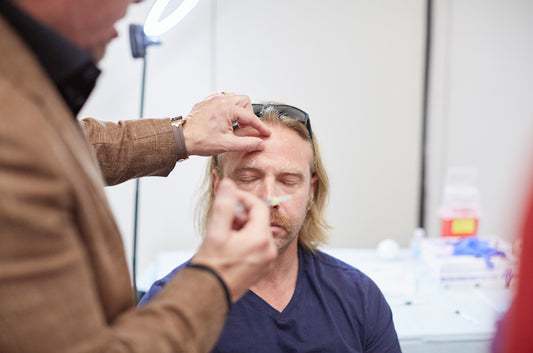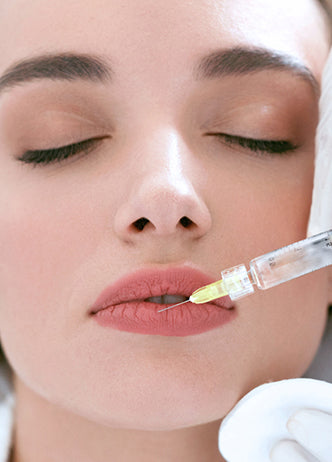Introduction
Lip fillers have become one of the most popular cosmetic procedures worldwide, offering instant volume and definition. While modern dermal fillers are generally safe and FDA-approved, complications can occur—most notably, allergic reactions to lip filler.
For aesthetic injectors and healthcare professionals, recognizing early signs of hypersensitivity and knowing how to respond promptly can prevent serious outcomes.
This article explores the causes, symptoms, diagnosis, and management of lip filler allergies—based on peer-reviewed research and clinical best practices. It also highlights the importance of advanced injector training for prevention and patient safety.
Understanding Lip Filler Allergies
What Are Lip Fillers Made Of?
Most modern lip fillers use hyaluronic acid (HA)—a naturally occurring substance in the skin that retains moisture and provides structure. HA-based fillers are biocompatible and reversible, making them the preferred choice for both beginners and advanced injectors.
However, although rare, allergic or inflammatory responses can occur due to:
-
Cross-linking agents (e.g., BDDE—1,4-butanediol diglycidyl ether) used to stabilize HA molecules
-
Lidocaine or other additives in filler formulations
-
Foreign-body immune responses or delayed hypersensitivity reactions
-
Contamination or poor aseptic technique
These reactions are uncommon, with estimated prevalence rates below 0.02% according to the Aesthetic Surgery Journal (NIH, 2021), but they require immediate and competent management when they occur.
Types of Allergic Reactions to Lip Filler
Allergic or adverse reactions are typically categorized as immediate, delayed, or chronic inflammatory:
1. Immediate Hypersensitivity Reaction
Occurs within minutes to hours post-injection. This is usually IgE-mediated and presents as:
-
Rapid-onset swelling or edema
-
Redness or urticaria (hives)
-
Itching or burning sensation
-
In rare cases, anaphylaxis (systemic allergic response)
Management:
Administer antihistamines (oral or IV) for mild cases, and epinephrine and corticosteroids for anaphylaxis. Airway management and emergency transfer may be necessary.
2. Delayed Hypersensitivity Reaction
Develops days to weeks after treatment and may result from immune sensitization or biofilm formation.
Symptoms include:
-
Firm, tender nodules
-
Persistent swelling
-
Redness and warmth
-
Sometimes fever or malaise
Treatment:
-
Oral corticosteroids for inflammation
-
Antibiotics if infection or biofilm suspected
-
Hyaluronidase injection (for HA fillers) to dissolve filler and reduce immune response
3. Chronic or Granulomatous Reaction
A granulomatous reaction is a long-term inflammatory response to filler particles, typically appearing months to years later.
Clinical features:
-
Hard lumps or irregular nodules
-
Persistent edema
-
Discoloration or asymmetry
Management:
-
Hyaluronidase injections
-
Intralesional corticosteroids (e.g., triamcinolone)
-
Referral to dermatology or plastic surgery for resistant cases
Differential Diagnosis: Not Every Swelling Is an Allergy
A key challenge in aesthetic medicine is distinguishing between normal post-procedural swelling and a true allergic response.
|
Condition
|
Timing
|
Symptoms
|
Treatment
|
|---|---|---|---|
|
Normal swelling
|
24–48 hours
|
Mild edema, tenderness
|
Cold compress, NSAIDs
|
|
Vascular occlusion
|
Immediate
|
Blanching, pain, tissue ischemia
|
Hyaluronidase, massage, nitroglycerin
|
|
Infection
|
2–7 days
|
Warmth, pus, fever
|
Antibiotics
|
|
Allergic reaction
|
Minutes to weeks
|
Diffuse swelling, redness, itching
|
Antihistamines, steroids, hyaluronidase
|
Proper injector training, such as the Comprehensive Dermal Filler Training Level I course, emphasizes differential diagnosis and step-by-step complication management protocols.
Evidence-Based Treatment of Lip Filler Allergic Reactions
1. Clinical Assessment
Evaluate the timeline, symptom progression, and any product components. Rule out vascular occlusion, infection, or trauma.
2. Pharmacologic Management
-
Antihistamines (e.g., cetirizine or diphenhydramine) for mild allergic edema
-
Systemic corticosteroids for moderate or severe inflammation
-
Epinephrine for anaphylaxis
-
Antibiotics if biofilm suspected
3. Hyaluronidase Administration
For HA-based fillers, hyaluronidase remains the gold-standard intervention. It not only dissolves the filler but also reduces immune-mediated swelling.
Injectors must understand proper dilution, dosage, and safety considerations—skills covered in the Complications Mastery Program for aesthetic professionals.
4. Follow-Up and Monitoring
Patients should be reassessed within 24–48 hours to confirm symptom resolution. Persistent or recurrent inflammation warrants referral to an allergist or dermatologist for immunologic evaluation.
Prevention: Best Practices for Safe Lip Filler Injections
While not all allergic reactions can be predicted, several steps drastically reduce risk:
-
Perform a detailed patient history. Ask about allergies to lidocaine, previous filler reactions, autoimmune conditions, and medication use.
-
Use FDA-approved fillers only. Avoid gray-market or counterfeit products.
-
Adhere to aseptic technique. Minimize contamination risk.
-
Inject conservatively and symmetrically. Overcorrection increases immune response risk.
-
Provide post-procedure instructions. Educate patients on normal vs. abnormal swelling.
-
Maintain emergency preparedness. Always have epinephrine, corticosteroids, and hyaluronidase on hand.
Proper injector training is the best prevention strategy. Platforms like Empire On-Demand ensure clinicians are fully equipped to handle aesthetic complications safely and confidently.
The Importance of Continuing Education
Even experienced injectors must stay current with evolving filler formulations, complication algorithms, and safety protocols.
Courses like Comprehensive Dermal Filler Training and the Complications Mastery Program by Empire On-Demand are designed specifically for medical professionals to master the technical and diagnostic skills required for excellence in aesthetic medicine.
Ongoing education ensures compliance, reduces risk, and builds patient trust—foundations of a successful and ethical aesthetic career.
Conclusion: Confidence Comes from Competence
An allergic reaction to lip filler is rare but serious. Recognizing the difference between expected swelling and a true hypersensitivity response can save a patient from long-term complications.
The key is evidence-based training and preparation. Every injector should know how to assess, treat, and prevent filler-related complications with clinical precision.
By investing in high-quality education from Empire On-Demand, clinicians elevate both patient safety and professional credibility—transforming potential complications into opportunities for excellence.
Call to Action
Master the art and safety of injectables. Join Empire On-Demand’s physician-led courses like Comprehensive Dermal Filler Training Level I and Complications Mastery Program to learn how to prevent, identify, and treat lip filler reactions effectively.
FAQs
1. How common are allergic reactions to lip fillers?
Extremely rare—occurring in less than 0.02% of cases, according to NIH data.
2. What causes a lip filler allergy?
Cross-linking agents, lidocaine, or immune sensitization to filler components.
3. How do I know if it’s an allergy or normal swelling?
Allergies present with itching, redness, and prolonged or diffuse swelling beyond 48 hours.
4. Can hyaluronic acid fillers cause allergies?
Yes, but rarely. The reaction is usually to additives, not HA itself.
5. How are lip filler allergies treated?
With antihistamines, corticosteroids, and hyaluronidase for HA fillers.
6. Can lip filler allergies be prevented?
Yes—through careful screening, sterile technique, and use of reputable products.
7. What should I do if a patient develops severe swelling?
Stop the procedure immediately, administer antihistamines or steroids, and if necessary, epinephrine.
8. Do I need special training to manage filler complications?
Absolutely—programs like the Complications Mastery Program teach essential protocols.
9. Can delayed reactions occur months later?
Yes, delayed inflammatory or granulomatous reactions may appear long after injection.
10. When should I refer a patient to a specialist?
If symptoms persist beyond 48–72 hours or systemic reactions are suspected.
References
-
DeLorenzi, C. (2021). Complications of injectable fillers, part I: Causes and management. Aesthetic Surgery Journal, 41(8), 942–956.
-
National Institutes of Health. (2021). Hypersensitivity and inflammatory reactions to hyaluronic acid fillers.
-
Mayo Clinic. (2023). Dermal fillers: Risks, side effects, and safety tips.
-
Empire On-Demand. (2025). Comprehensive Dermal Filler and Complication Management Curriculum.










